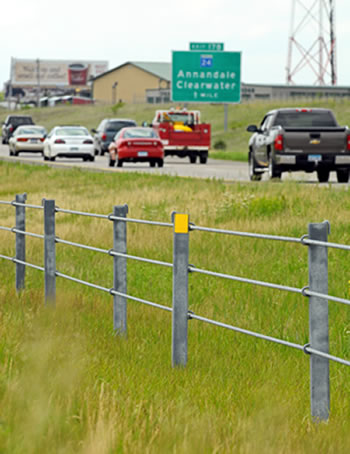|
By Nick Carpenter

Sixteen cable median barrier projects, such as this one on Interstate 94 in Sauk Centre, are scheduled to be constructed statewide in 2009. The Sauk Centre project is one of two cable median barrier projects funded by the American Recovery and Reinvestment Act. Photo by David Gonzalez |
Traveling on Interstate 94 through central Minnesota will get a little bit safer come August, when work is scheduled to be completed on a 12-mile cable median barrier installation project in Sauk Centre.
The project marks one of the final phases of cable median barrier construction along I-94 in District 3. By the end of 2009, central Minnesota will have 70 miles of cable median barrier installed along I-94, with future plans to install 30 additional miles by early 2011.
Installing cable median barrier strategically on identified sections of highway like I-94 in Sauk Centre is a key effort toward the department’s goal of reducing the risk of transportation-related fatalities and severe injuries.
“High tension cable median barrier is designed to help prevent head-on collisions when drivers inadvertently cross the center median and collide with oncoming traffic,” said Dan Labo, District 3 project manager. “This project will significantly reduce the risk of motorists being involved in a fatal or disabling accident.”
The Sauk Centre project represents one of 16 cable median barrier projects that are scheduled to be constructed statewide in 2009. It also represents one of two cable median barrier projects funded by the American Recovery and Reinvestment Act.
With 139.4 miles of cable median barrier already installed throughout the state and 96.5 miles funded for construction from 2009-2011, the department already has plans for 79 additional miles that are currently unfunded.
While it typically costs about $125,000 to install one mile of cable median barrier, there are instances where additional funds are necessary.
“Added costs are introduced if there are issues with the cross section of the median area,” said Julie Whitcher, assistant state traffic safety engineer. “If it is determined that a side slope is too steep, we may have to grade or provide cable median barrier for both directions.”
Most cable median barriers are not designed to stop large vehicles, like semitrailers, from crossing into oncoming traffic.
However, cable barrier systems used in Mn/DOT projects must be able to contain and redirect impacting vehicles in accordance with standard Test Level 3 or Test Level 4, according to the National Cooperative Highway Research Program Report 350.
Test Level 3 is based on a 3/4 three-quarter-ton pick-up truck weighting 4,400 pounds, traveling at 62 mph with an impact angle of 25 degrees. Test Level 4 is based on a single-unit truck weighting 17,650 pounds, traveling at 50 mph with an impact angle of 15 degrees.
Cable median barriers work
From January 2001 through December 2007, the Office of Traffic, Safety and Technology conducted a cross-median crash study of a 10.5-mile section of cable median barrier on I-94 in Maple Grove. Crews installed the barrier in 2004.
Before installation of the barrier, six fatalities occurred on the identified stretch of I-94, five of which were related to vehicles crossing the median and striking vehicles traveling in the opposite direction.
Besides the fatalities, there were 29 other crossover crashes where a vehicle traveling in the opposing direction was struck and 27 more vehicles that ended up in the center median.
After installation of the cable median barrier, zero fatalities were reported, with only 10 vehicles managing to cross the cable median barrier and seven making it into the opposing lanes of traffic.
|



